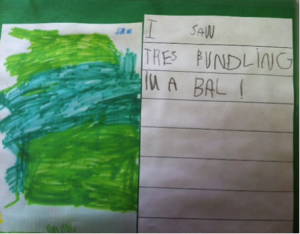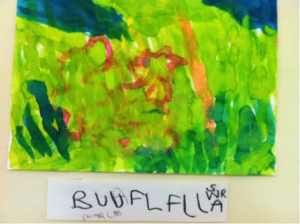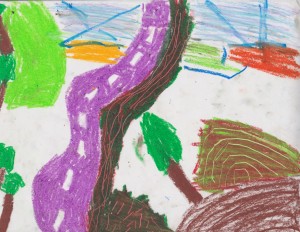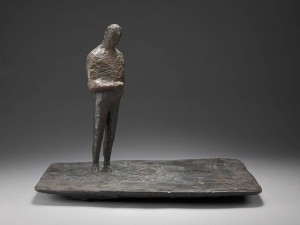I walk up and down this staircase almost every day. Today, I saw a new reflection, a new light.
Here’s an invitation to see something familiar in a new way.
By Hallie Cirino, 5’s teacher, CHT Preschool, Westport, CT
One of the great joys of teaching in a school which embraces an emergent curriculum is finding artists whose works reflect the interests of the children. Recently, my co-teacher, Sylvia Grannan, and I noticed an emerging curiosity in jungle animals, so Sylvia said, “Why not study Rousseau?”
We hung colored copies of a small selection of Henri Rousseau’s vibrant paintings on a classroom wall, and waited for the children of our pre-K class to take notice. Our students were immediately drawn in, informally pointing and discussing Rousseau’s work. “Look at those monkeys!” “I like the flowers.” “The moon is full.”
The next day, we set out blank white paper, markers, crayons, pencils, and pastels, and asked the children to “write” what they notice about the paintings. Every one of them first drew what stood out to them, and then wrote a sentence about it. The students each took a turn to share what they had drawn and written.


A few days later we revisited their writings, and decided to write a collaborative class poem. The children started the poem by making a list of all the things they noticed in the paintings. We told them that these words are called nouns. The students then added action words to express what the objects/animals were doing in the paintings. Finally, they added descriptive words (adjectives). This was incredibly challenging yet fun for our five-year-olds! Here is their Ode to Rousseau:
Feathered owl resting
Happy monkey swinging
Leafy flower growing
Red plants waving
Tall trees bundling
Round orange sitting
Furry lion sniffing
White moon glowing
Tired girl sleeping
Stringy guitar laying
Serious person standing
Fun city spinning
Along the way, we read parts of a biography about Rousseau, which included the interesting fact that he had never seen a jungle and painted largely from his imagination. At the end of our artist study, we put out paints in the colors of Rousseau’s jungle paintings. The children were invited to use their imaginations, and paint whatever Rousseau had inspired. One of the children wanted to entitle his, and pretty soon they all had titles, from “Beautiful Flowers” to “Hiding Jungle”.


The students of our class are now showing an emerging interest in sharks…
“We just had the greatest class discussion! The vocabulary, the ideas, the connections…BUT, when it came to writing it down, they fell apart.” Does this sound familiar? We’ve all seen how easy it is to lose the magic when they face the blank page. How we handle the delicate transition to writing is the key to getting students to transfer their spoken language to the paper.
We often over-structure this transition, offering sentence starters and writing prompts which only serve to limit the children. Just as often, we give too much freedom, trusting that their enthusiasm for the painting will spill onto their paper. Both approaches usually result in blank pages. Offering the right balance of support is key. Here are two steps that ease the path to writing:
1. Allow time for drawing. With limited time in our schedules, I know it is tempting to jump to the writing. But I can’t overstate the value of taking the time to draw first. Drawing helps them – and us – see what they want to say. After discussing a painting, ask them to copy all or part of it, or they can draw something that the painting made them think of from their own lives. This helps them find their own writing voices.
Below, a third grade student has copied a painting from a postcard.


2. Provide Writing Invitations. These are key to helping students transfer their ideas to writing. Below are some Writing Invitations that I have used to guide students, while still allowing them enough choice to use their own voices. I always give at least two invitations, and I always “Your choice” (the child who chooses that one has thought of something I haven’t – and I am usually pleasantly surprised).
Sample Writing Invitations:
– Imagine yourself into your picture. What happens around you? Use all your senses to write a description or a story. (Other ways to say this: “Press play as if this painting is a video. What happens when it starts?” Or, “Start by telling what you smell, hear, see, or feel. Be detailed so I can imagine exactly what it’s like.”)
– Describe this painting. Be as detailed and descriptive as you can, and surprise me. (This is where metaphors and similes begin to show up).
– Write about what you were thinking as you drew. Where did your mind take you? What did you wonder and notice? What was easy or hard about drawing this picture? What surprised you?
– (for masks, statues, or portraits) Can you become this person for a while and write about your day?
– Does this picture/art piece make you think of a real place you’ve been, or a moment in your life? Include the sounds, the smells, the feeling of your memory.
– Your choice
There are unlimited Writing Invitations. You will think of what fits the needs of your class. For young children, sentence starters are not the enemy! Giving them the first few words can kick-start things for them (stick to something open-ended such as “I see/smell/feel/hear….” rather than something more constraining like, “I like this painting because…”).
After copying Hockney’s painting, this third grader reacted to the second invitation from above. She wrote:
“There is a squiggly purple road heading south. On the left there is a crowded tree place with one humpy hill. On the right of the road there is a grassy place with a garden. Down south the road leads to a rural kind of place which looks like precious glass.”
For teachers: Copy a painting into your journal, and use an invitation to write about it. What was your process like? What was surprising? Share your experience with your class – and with us!
Here’s a classroom activity using Reg Bulter’s Man (early 1960s) from the online collection.
Lesson: Explore the value of location, view-point, and narration.
Activity: class drawing, reading, and writing
Process: Use all three images from the online collection
Draw image (10 min) whole or detail. Respond in writing to the following questions (5 min). What is the mood? What is the story?

Draw second image (10 min) whole or detail. Respond in writing to the following questions (5 min): What is the mood from this perspective? What is the story?
Draw third image (10 min) whole or detail. Respond in writing to the following questions (5 min): What is the mood from this perspective? What is the story?
Reflection and follow up: If you had only seen one of these images what would you know in terms of mood and story?
In what ways might we use our classwork today towards understanding the effect of location, view-point, and mood when we read literature? When viewing works online? When reading a news story?
Example: Although I generated the lesson for the students and their needs, I too benefit from ‘seeing perspective’ and participating with them. Here’s a clip from my journal covering two of the steps.

Place in the Classroom
The activity generated quite a bit of conversation in the classroom the following day. Students gained perspective on a range of skills and frameworks — from seeing perspective to the role of location in story telling.
–James Shivers